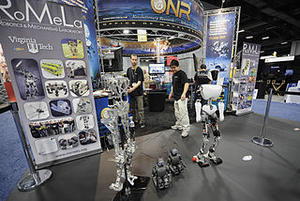First response at seaRobot for shipboard firefighting
In both war and peace, fire in the shipboard environment is serious and frequently results in excessive damage and high repair costs because the fire is not detected or controlled adequately; researchershave developed a humanoid robot that could fight fires on the next generation of combatants

SAFFiR prototypes on display // Source: wikimedia.org
In both war and peacetime scenarios, fire in the shipboard environment is serious and frequently results in excessive damage and high repair costs because the fire is not detected or controlled adequately. To help further improve future shipboard firefighting capability, scientists at the Naval Research Laboratory have formed an interdisciplinary team to develop a humanoid robot that could fight fires on the next generation of combatants. A humanoid-type robot was chosen because it was deemed best suited to operate within the confines of an environment that was deigned for human mobility and offered opportunity for other potential war fighting applications within the Navy and Marine Corps.
A U.S. Navy Research Laboratory release reports that the firefighting robot, called the Shipboard Autonomous Firefighting Robot (SAFFiR), is being designed to move autonomously throughout the ship, interact with people, and fight fires, handling many of the dangerous firefighting tasks that are normally performed by humans. The humanoid robot should be able to maneuver well in the narrow passages and ladderways that are unique to a ship and challenging for most older, simpler robots to navigate.
The robot is designed with enhanced multi-modal sensor technology for advanced navigation and a sensor suite that includes a camera, gas sensor, and stereo IR camera to enable it to see through smoke. Its upper body will be capable of manipulating fire suppressors and throwing propelled extinguishing agent technology (PEAT) grenades. It is battery powered that holds enough energy for 30 minutes of firefighting. Like a sure-footed sailor, the robot will also be capable of walking in all directions, balancing in sea conditions, and traversing obstacles.
The release notes that another key element of the SAFFiR development is to allow damage control personnel and the robot to work cohesively as a team. Algorithms are being developed to allow autonomous mobility and decision making by the robot as a team member. To enable natural interaction with a human team leader, the robot will have multimodal interfaces that will enable the robot to track the focus of attention of the human team leader, as well as to allow the robot to understand and respond to gestures, such as pointing and hand signals. Where appropriate, natural language may also be incorporated, as well as other modes of communication and supervision.
Researchers from Virginia Tech and University of Pennsylvania are also working with NRL on the project. They plan to test the firefighting robot in a realistic firefighting environment onboard the ex-USS Shadwell in late September 2013.
The ex-USS Shadwell (LSD-15), one of the world’s unique fire test ships, is located in Mobile, Alabama. It is used to conduct full-scale fire and damage control tests, using the reality conformations of active duty sailors.
